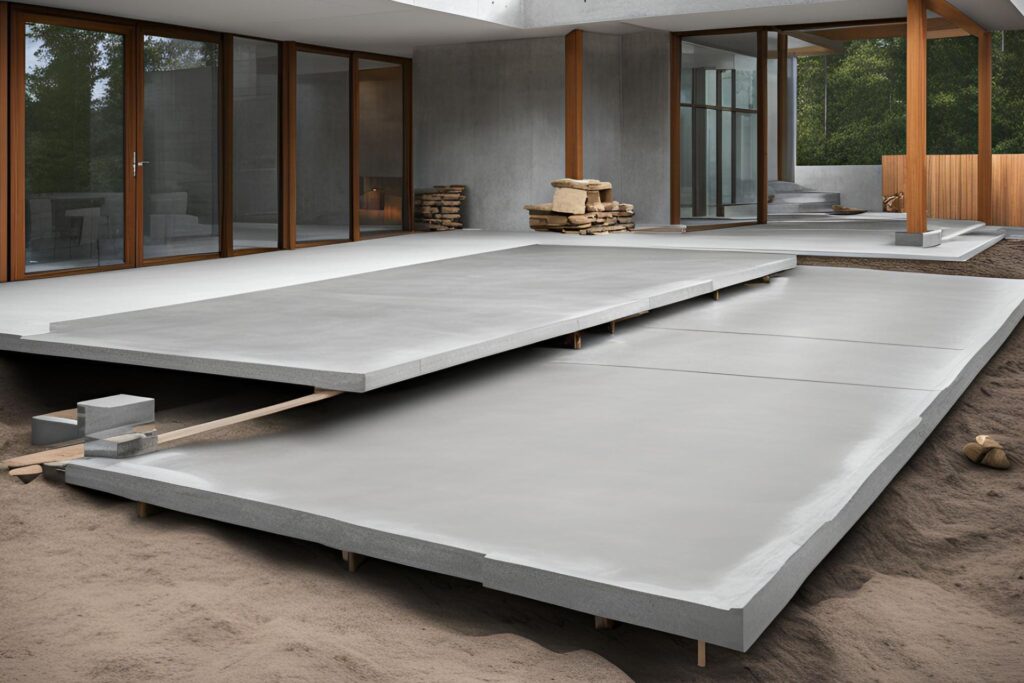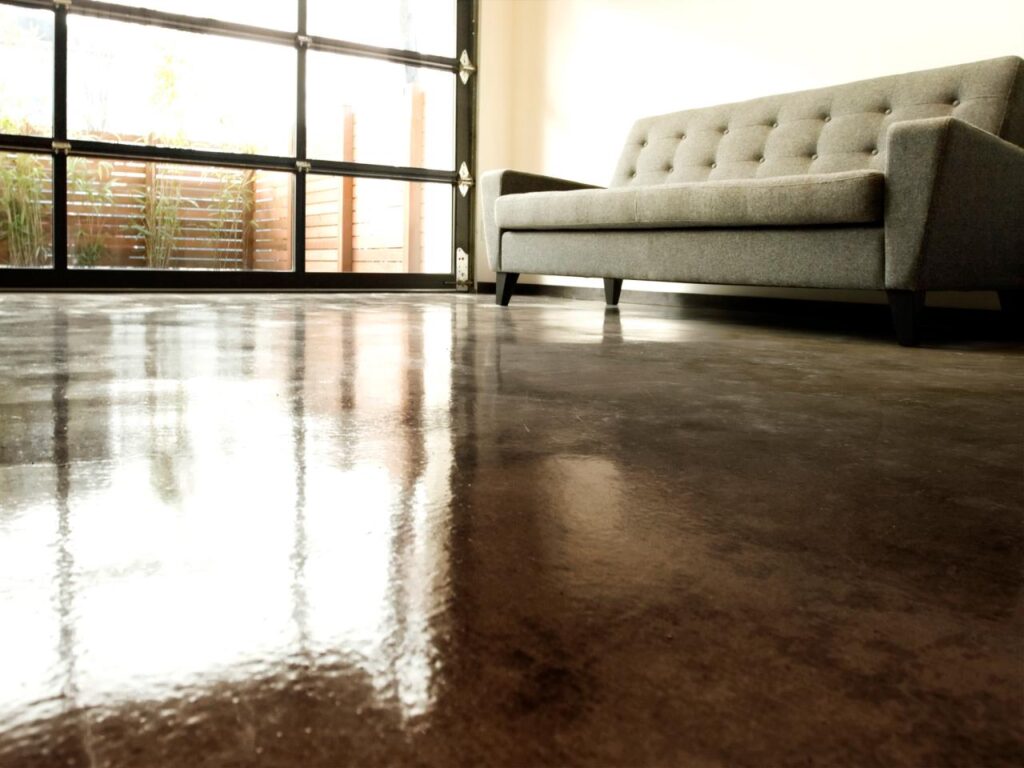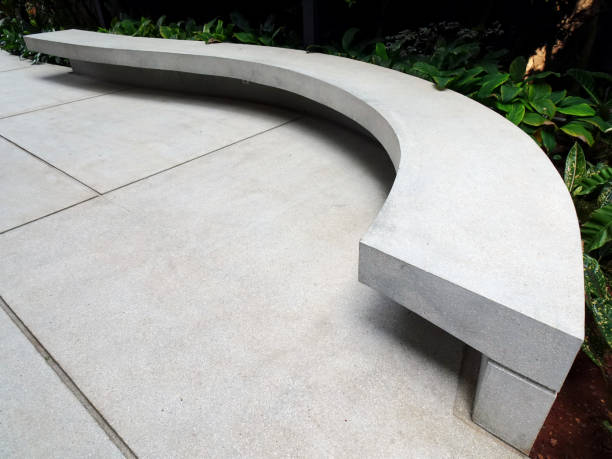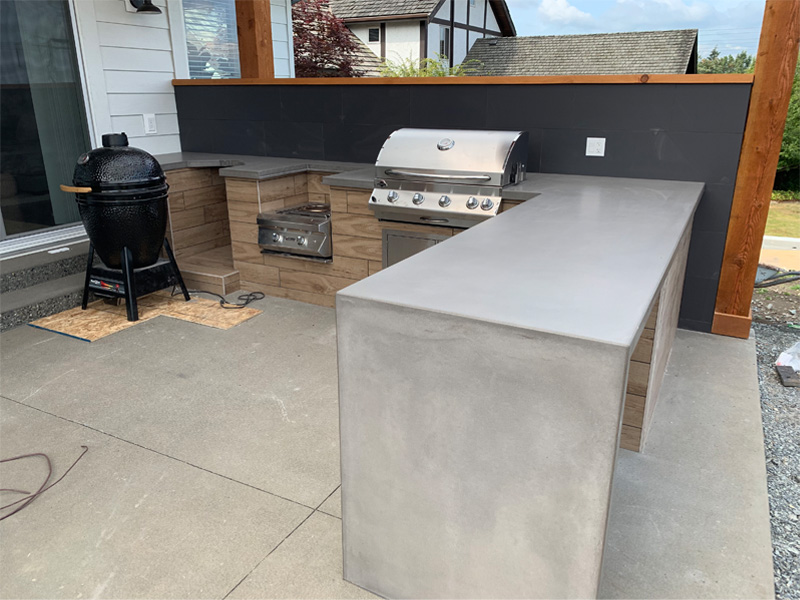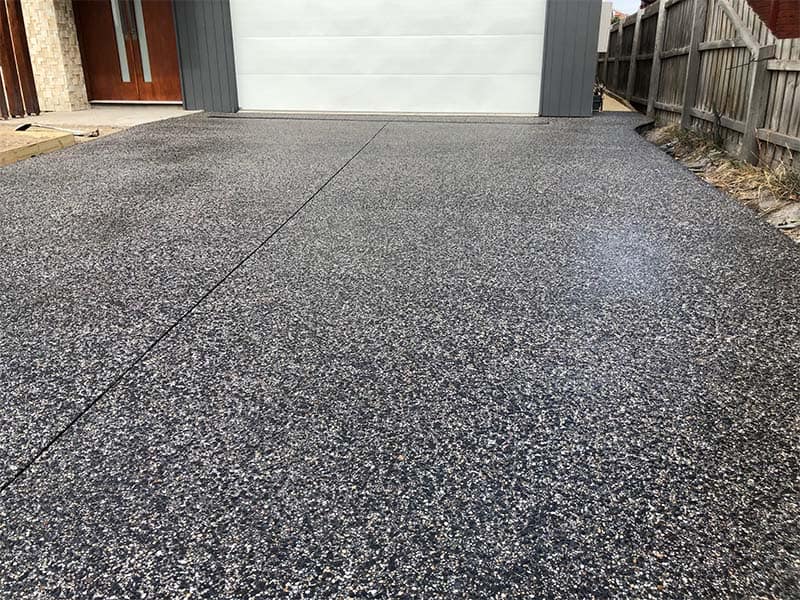Welcome to our comprehensive guide on the pros and cons of a concrete slab foundation. Choosing the right foundation for your home is a crucial decision that impacts everything from construction costs to long-term maintenance and energy efficiency. In this article, we’ll delve into what makes concrete slab foundations a popular choice, exploring their advantages, such as cost-effectiveness, durability, and low maintenance, while also addressing potential drawbacks like cracking, repair difficulties, and thermal discomfort. Whether you’re planning a new build or considering foundation options for an existing structure, this guide will provide you with the insights needed to make an informed decision.
A concrete slab foundation is a cost-effective, durable, and low-maintenance option for home construction. It offers advantages such as resistance to pests, energy efficiency, and quick installation. However, it also has drawbacks, including the potential for cracking, difficulty in making repairs, and susceptibility to cold floors without proper insulation. Understanding these pros and cons can help homeowners decide if a concrete slab foundation is the right choice for their needs.
- Understanding Concrete Slab Foundations
- Advantages Of A Concrete Slab Foundation
- Disadvantages Of A Concrete Slab Foundation
- Comparing Concrete Slab Foundations To Other Foundation Types
- Factors To Consider When Choosing A Foundation
- Expert Opinions And Real-Life Examples
- FAQs: About What Are The Pros And Cons Of A Concrete Slab Foundation?
- What is a concrete slab foundation?
- What are the main advantages of a concrete slab foundation?
- What are the common disadvantages of a concrete slab foundation?
- How does a concrete slab foundation compare to a basement foundation?
- Can a concrete slab foundation crack?
- How is a concrete slab foundation constructed?
- Is a concrete slab foundation suitable for all types of homes?
- How does a concrete slab foundation impact energy efficiency?
- What maintenance is required for a concrete slab foundation?
- How does soil type affect the suitability of a concrete slab foundation?
- Conclusion
Understanding Concrete Slab Foundations
Concrete slab foundations are a popular choice for many buildings due to their durability and simplicity. Here’s an in-depth look at what they are, how they are constructed, and the different types available.
Definition
A concrete slab foundation is a flat, horizontal surface made of concrete, typically used as a base for building construction. This foundation type provides a solid and level support structure for buildings, helping distribute the weight evenly across the ground. Concrete slabs can vary in thickness, but they are generally between 4 to 6 inches thick, and reinforced with steel bars or mesh for added strength and stability.
Construction Process
The construction of a concrete slab foundation involves several crucial steps to ensure a strong and durable base. Here’s a detailed breakdown of the process:
Site Preparation
1. Clearing and Excavation: The first step is clearing the construction site of any vegetation, debris, and existing structures. This process also involves excavating the ground to the required depth, ensuring a level surface.
2. Soil Compaction: After excavation, the soil is compacted to provide a stable base. This step is critical to prevent settling and shifting that can lead to foundation cracks.
3. Formwork Installation: Wooden or metal forms are set up around the perimeter of the intended slab area. These forms act as molds that hold the concrete in place during pouring and curing.
4. Gravel and Vapor Barrier: A layer of gravel is spread within the forms to aid drainage and prevent moisture from seeping into the slab. Additionally, a vapor barrier, typically a plastic sheet, is placed over the gravel to further block moisture.
Pouring the Concrete
1. Mixing the Concrete: Concrete is mixed either on-site or delivered pre-mixed. The mixture usually consists of cement, sand, gravel, and water, with possible additives for specific properties like faster curing or increased strength.
2. Pouring: The mixed concrete is then poured into the prepared forms. It’s spread evenly and compacted using tools like shovels and rakes to remove air pockets and ensure a uniform surface.
3. Leveling and Smoothing: After pouring, the concrete surface is leveled and smoothed using a screed board and trowels. This step is vital for achieving a flat and even foundation.
Curing Process
1. Initial Setting: The concrete begins to set and harden within a few hours of pouring. During this time, it’s essential to keep the surface moist to prevent cracking.
2. Curing: Curing is the process of maintaining adequate moisture and temperature conditions for the concrete to achieve its full strength. This process can take anywhere from a few days to a few weeks, depending on the concrete mix and environmental conditions.
3. Final Hardening: After the curing period, the concrete slab reaches its full strength and hardness, ready to support the structure’s weight.
Types of Concrete Slab Foundations
There are several types of concrete slab foundations, each suited for different building needs and soil conditions. Here are two common types:
Monolithic Slabs
A monolithic slab is poured all at once, forming a single, continuous piece of concrete. This type of slab includes thickened edges that act as the foundation’s footing, providing additional support. Monolithic slabs are quicker and more cost-effective to construct, making them a popular choice for residential buildings.
Post-Tensioned Slabs
Post-tensioned slabs incorporate steel cables or tendons that are tensioned after the concrete has been poured and partially cured. This process increases the slab’s strength and allows it to span larger areas without the need for additional support beams. Post-tensioned slabs are often used in commercial buildings and structures with challenging soil conditions.
Understanding concrete slab foundations is crucial for anyone involved in construction or looking to build a new structure. These foundations offer a robust and reliable base, ensuring the longevity and stability of the building. By knowing the construction process and the types available, you can make informed decisions that best suit your project’s needs.

Advantages Of A Concrete Slab Foundation
Concrete slab foundations offer several benefits that make them an attractive option for many homeowners and builders. Here’s a comprehensive look at the advantages of opting for a concrete slab foundation:
Cost-Effective
One of the primary reasons many people choose a concrete slab foundation is its cost-effectiveness. Concrete slabs can be significantly less expensive than other foundation types, such as basements or crawl spaces. This cost advantage comes from several factors:
Reduced Excavation Costs: Unlike basements that require deep digging, concrete slabs need only shallow excavation, which reduces labor and machinery expenses.
Quicker Construction Time: Concrete slabs can be poured and set in a matter of days, speeding up the construction timeline. This efficiency translates to lower labor costs and allows homeowners to move into their new homes faster.
Durability and Strength
Concrete slab foundations are known for their exceptional durability and strength. Here’s why they stand out:
Robustness and Longevity: Concrete is an incredibly tough material that can withstand heavy loads and extreme weather conditions. A properly installed concrete slab can last for decades without significant issues.
Resistance to Pests: Unlike wood foundations, concrete slabs are impervious to termites and other pests that can cause severe structural damage. This resistance helps maintain the integrity of the foundation over time.
Energy Efficiency
Concrete slabs contribute to a home’s energy efficiency in several ways:
Thermal Mass: Concrete has excellent thermal mass properties, meaning it can absorb and store heat during the day and release it at night. This natural temperature regulation helps keep indoor temperatures stable, reducing the need for heating and cooling.
Reduced Air Infiltration: With no gaps or crawl spaces under the house, concrete slabs minimize air infiltration, keeping conditioned air inside and reducing energy costs.
Low Maintenance
Another significant advantage of concrete slab foundations is their low maintenance requirements. Here’s what makes them so easy to care for:
Minimal Repairs Needed: Concrete slabs are less likely to suffer from issues like rot, mold, or warping compared to wood foundations. This durability means fewer repairs and maintenance tasks over the years.
Simple Cleaning: The surface of a concrete slab is easy to clean and maintain, requiring only occasional sweeping and mopping to keep it in good condition.
Versatility
Concrete slab foundations offer remarkable versatility, making them suitable for various building styles and terrains:
Adaptable Design: Whether you’re building a modern home, a traditional ranch-style house, or anything in between, concrete slabs can be tailored to fit your architectural needs.
Suitable for Various Terrains: Concrete slabs can be poured on almost any type of terrain, including flat, sloped, or uneven ground. This adaptability makes them a viable option for many different building sites.
In conclusion, concrete slab foundations provide numerous advantages, from cost savings and durability to energy efficiency and low maintenance. Their versatility and robustness make them a smart choice for many construction projects, ensuring a solid foundation that stands the test of time.
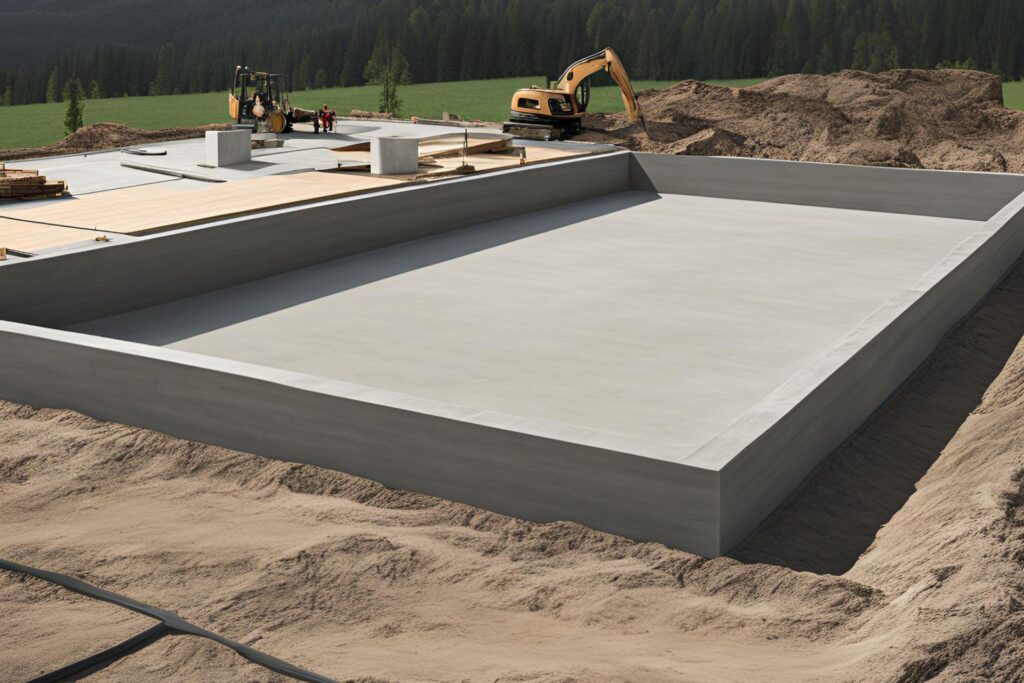
Disadvantages Of A Concrete Slab Foundation
While concrete slab foundations offer many benefits, they come with their own set of drawbacks that homeowners should be aware of before making a decision.
Potential for Cracking
One of the primary concerns with concrete slab foundations is the potential for cracking. This issue often arises due to soil movement and temperature changes. When the soil beneath a slab expands or contracts, it can place stress on the concrete, leading to cracks. Additionally, temperature fluctuations can cause the concrete to expand and contract, which might result in further cracking.
To mitigate these risks, proper construction techniques and soil preparation are crucial. Ensuring that the soil is well-compacted and stable can help reduce the likelihood of movement. Moreover, using control joints in the slab can help manage where the cracks occur, minimizing their impact on the structural integrity of the foundation.
Difficulty in Repairs
Concrete slab foundations can pose significant challenges when it comes to repairs, particularly for plumbing and electrical systems located beneath the slab. Accessing these systems requires breaking through the concrete, which is both time-consuming and costly. For instance, if there is a plumbing leak under the slab, the concrete must be cut open, the issue fixed, and then the slab must be repaired and resurfaced. This process can be expensive and disruptive to the household.
Homeowners should consider these potential complications when choosing a slab foundation, as repair costs can add up quickly if issues arise. It’s important to weigh these potential repair challenges against the initial cost savings of a slab foundation.
Thermal Discomfort
Concrete can also contribute to thermal discomfort within a home. Without proper insulation, a concrete slab can feel cold underfoot, especially in cooler climates. This can lead to increased heating costs as homeowners attempt to maintain a comfortable indoor temperature.
One effective solution to this problem is the installation of radiant floor heating. This system involves embedding heating elements within the concrete slab, which can help keep the floor warm and provide a more consistent overall temperature in the home. While this adds to the initial construction cost, it can greatly enhance comfort and reduce long-term energy expenses.
Flood Risk
Homes built on concrete slab foundations are particularly vulnerable to flooding, especially in areas with high water tables or heavy rainfall. Since the slab is close to the ground, it can be easily affected by rising water levels, leading to water damage and potential mold growth.
To protect against this risk, it’s essential to ensure proper drainage around the home. This includes grading the landscape to direct water away from the foundation and installing appropriate drainage systems, such as French drains or sump pumps. Taking these preventative measures can help safeguard the home from flood damage.
Limited Crawl Space
Another disadvantage of concrete slab foundations is the lack of crawl space. Unlike homes with raised foundations, there is no space beneath the slab for additional storage or for housing mechanical systems like HVAC units.
This limitation means that any maintenance or repairs to these systems can be more challenging and intrusive. For instance, servicing ductwork or plumbing requires accessing it from inside the home rather than a crawl space, which can be more cumbersome.
In summary, while concrete slab foundations offer several advantages, they also come with significant disadvantages, including the potential for cracking, difficulty in repairs, thermal discomfort, flood risk, and limited crawl space. Homeowners should carefully consider these factors and consult with professionals to determine if a slab foundation is the best choice for their specific needs and circumstances.
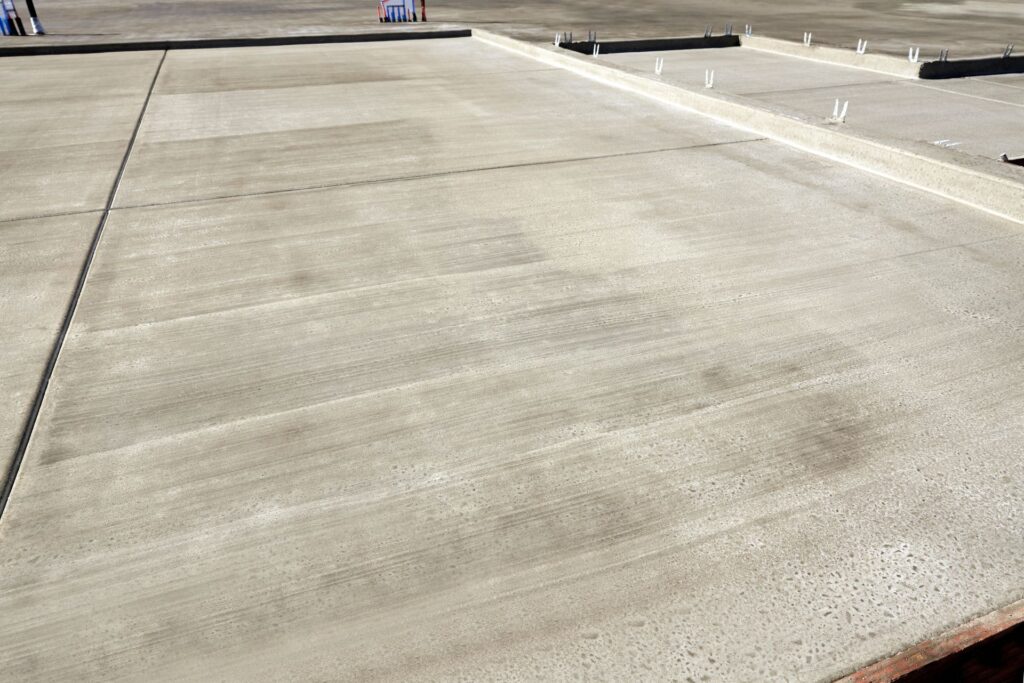
Comparing Concrete Slab Foundations To Other Foundation Types
Concrete Slab vs. Basement
When comparing concrete slab foundations to basement foundations, several key factors come into play: cost, construction time, usability, climate suitability, and the potential for additional living space.
Cost
Concrete slab foundations are generally more cost-effective than basement foundations. The materials and labor required for a slab are less intensive, resulting in lower overall costs. Basements, on the other hand, involve significant excavation, waterproofing, and structural support, which can substantially increase expenses.
Construction Time
Construction time for concrete slabs is typically shorter. Since slabs involve pouring concrete directly onto a prepared surface, they can be completed relatively quickly. Basement foundations require more complex construction steps, including digging, forming walls, and ensuring proper drainage, all of which extend the timeline.
Usability
Basements offer additional usable space, which can be a significant advantage for homeowners looking for extra storage or living areas. They can be finished to include bedrooms, family rooms, or even home gyms. Concrete slabs, while simpler, do not offer this additional below-ground space, making them less versatile in terms of usability.
Climate Suitability
The choice between a slab and a basement can also depend on climate. In regions with high water tables or frequent flooding, basements may be prone to water infiltration, making slabs a more practical option. Conversely, in colder climates, basements provide better insulation against the cold, making them a preferable choice for energy efficiency and comfort.
Potential for Additional Living Space
Basements inherently offer more potential for additional living space compared to concrete slabs. This can be a major selling point for homes with basements, as they can be adapted for various uses over time. However, finishing a basement involves additional costs and time, which should be considered when evaluating overall benefits.
Concrete Slab vs. Crawl Space
When comparing concrete slabs to crawl space foundations, the discussion often revolves around maintenance, energy efficiency, pest control, accessibility for repairs, and moisture control.
Maintenance
Concrete slabs generally require less maintenance compared to crawl spaces. Since slabs are solid and have no voids underneath, there’s less risk of issues such as moisture buildup, pests, or structural damage over time. Crawl spaces, on the other hand, can be susceptible to these problems, necessitating regular inspections and maintenance.
Energy Efficiency
Concrete slabs can offer superior energy efficiency. Because they are in direct contact with the ground, they can help maintain stable indoor temperatures, reducing the need for heating and cooling. Crawl spaces, if not properly insulated and sealed, can allow air leakage, making it harder to regulate indoor temperatures efficiently.
Pest Control
Concrete slabs are generally better at preventing pest infestations. The solid nature of the slab leaves fewer entry points for pests like rodents or insects. Crawl spaces, with their open areas, can become a haven for pests unless properly managed and sealed.
Accessibility for Repairs
Crawl spaces provide easier access for repairs. Plumbing, electrical systems, and HVAC units are often routed through crawl spaces, making them more accessible for maintenance and repairs. In contrast, any issues with systems embedded in a concrete slab can be more challenging and costly to address.
Moisture Control
Moisture control is another crucial factor. Concrete slabs, if properly constructed with vapor barriers, are less prone to moisture issues. Crawl spaces, however, can be more vulnerable to moisture from the ground, which can lead to mold, mildew, and structural problems if not adequately managed. Proper ventilation and moisture barriers are essential to mitigate these risks in crawl spaces.
By understanding these differences, homeowners and builders can make more informed decisions about which foundation type best suits their needs, taking into account factors like cost, usability, maintenance, and environmental considerations.

Factors To Consider When Choosing A Foundation
When embarking on a construction project, one of the most critical decisions you’ll make is choosing the right foundation. This choice isn’t just about ensuring your building stands tall and strong; it also impacts your project’s budget, long-term maintenance, and future adaptability. Here are the key factors to consider:
Climate and Soil Conditions
The local climate and soil type play a pivotal role in determining the most suitable foundation for your building.
Climate: If you’re in an area prone to heavy rainfall, flooding, or extreme temperatures, your foundation needs to be robust enough to withstand these conditions. For instance, areas with significant rainfall may benefit from deeper foundations or those with better drainage capabilities to prevent waterlogging and structural damage.
Soil Type: The type of soil on your site can greatly affect foundation performance. Sandy soils, for example, might require deeper foundations to reach stable ground, while clay soils can expand and contract with moisture changes, necessitating special consideration to avoid cracking and shifting. Conducting a soil test before deciding on your foundation type is essential to avoid future problems.
Building Type and Design
The architectural style and intended use of your building also influence foundation choice.
Concrete Slabs: Concrete slabs are a popular choice for many modern architectural styles. They provide a clean, level base and are especially suitable for single-story buildings and homes in warm climates. However, they might not be the best option for every design. For example, homes with basements or multi-story buildings may require deeper foundations such as piers or crawl spaces to provide adequate support and access to utilities.
Architectural Styles: Different architectural styles may also dictate the type of foundation. For instance, traditional homes with heavy masonry walls may require stronger, more reinforced foundations compared to lightweight, modern designs that might do well with simpler, slab foundations.
Budget and Long-Term Costs
Budget constraints are always a consideration, but it’s essential to look beyond the initial cost when choosing a foundation.
Initial Costs: While a concrete slab might be cheaper to install than a full basement, it’s important to consider what you’re getting for your money. Initial savings can sometimes lead to higher long-term costs if the chosen foundation is not suitable for the site conditions or building design.
Long-Term Maintenance and Repair: Think about the long-term implications. A foundation that is more expensive initially but requires minimal maintenance may be more cost-effective over the building’s life. For example, a slab foundation in a stable climate may need very little maintenance, whereas a pier foundation in an area with shifting soils might require regular inspections and repairs.
Future Proofing
Your building needs today might not be the same in the future. Consider how your foundation choice can accommodate potential changes.
Additional Space: If you plan to expand your building in the future, choose a foundation that can support additional structures. A slab foundation might limit your ability to add basements or additional floors later on.
Modifications: Consider whether your foundation can easily accommodate future modifications. For instance, if you foresee the need for new utility lines or significant renovations, a crawl space foundation offers more flexibility than a slab, which can be difficult and expensive to alter.
Choosing the right foundation is a complex decision that impacts the overall success and longevity of your building. By considering the local climate and soil conditions, the type and design of your building, your budget, and future needs, you can make an informed choice that ensures stability and cost-effectiveness for years to come.

Expert Opinions And Real-Life Examples
Interview with a Builder/Contractor
To gain a deeper understanding of the practical aspects of concrete slab foundations, we spoke with John Thompson, a seasoned builder with over 20 years of experience in the construction industry. John has worked on numerous projects involving concrete slab foundations and shared his insights on the benefits and challenges associated with this type of foundation.
Pros of Concrete Slab Foundations
1. Durability: According to John, concrete slab foundations are incredibly durable and can withstand a variety of environmental conditions. “A well-constructed slab can last for decades without major issues,” he says.
2. Cost-Effective: John highlights that concrete slabs are generally more cost-effective than other types of foundations. “They require less excavation and fewer materials, which can lead to significant savings.”
3. Pest Resistance: “Unlike wooden foundations, concrete slabs are impervious to termites and other pests,” John points out. This can be a crucial factor in areas prone to termite infestations.
4. Energy Efficiency: John explains that concrete slabs can help with energy efficiency. “The thermal mass of the concrete can help maintain a stable indoor temperature, reducing heating and cooling costs.”
Cons of Concrete Slab Foundations
1. Limited Access for Repairs: One of the main drawbacks, according to John, is the difficulty in accessing plumbing and electrical systems embedded in the slab. “If there’s a problem with these systems, it often requires breaking through the concrete, which can be costly and disruptive.”
2. Potential for Cracking: While durable, concrete slabs can develop cracks over time. John advises regular inspections and maintenance to address minor cracks before they become significant issues.
3. Initial Setup: “The initial curing process of the concrete requires time and proper conditions,” John notes. “It’s essential to ensure the concrete is properly cured to prevent future problems.”
Case Study
To illustrate the real-life application of concrete slab foundations, let’s look at the example of Sarah and Mark Thompson, homeowners in Wellington. They opted for a concrete slab foundation when building their new home three years ago.
Background
Sarah and Mark were attracted to the idea of a concrete slab foundation due to its affordability and low maintenance. “We wanted a foundation that would be durable and resistant to pests, as we’ve had issues with termites in the past,” Sarah explains.
Experience
Since moving into their home, Sarah and Mark have been pleased with their decision. “The house has stayed cool in the summer and warm in the winter, thanks to the thermal properties of the slab,” Mark notes. They’ve also appreciated the pest resistance, as they’ve had no issues with termites or other pests.
However, they did encounter a minor challenge when they decided to add a new bathroom. “We had to break through the slab to install new plumbing, which was a bit of a hassle,” Sarah recalls. Despite this, they still believe the benefits outweigh the drawbacks.
Overall, Sarah and Mark’s experience highlights the practical advantages of concrete slab foundations, while also acknowledging the potential challenges. Their story underscores the importance of considering both the pros and cons when choosing a foundation type for your home.
By including expert opinions and real-life examples, this section aims to provide a comprehensive and relatable perspective on concrete slab foundations, helping you make an informed decision for your construction project.

FAQs: About What Are The Pros And Cons Of A Concrete Slab Foundation?
What is a concrete slab foundation?
A concrete slab foundation is a flat, single-layer concrete base used as the foundation for a building. It is poured directly onto the ground, providing a stable and durable platform for construction.
What are the main advantages of a concrete slab foundation?
The main advantages include cost-effectiveness, durability, low maintenance, resistance to pests, energy efficiency, and quick installation. These benefits make it a popular choice for many homeowners.
What are the common disadvantages of a concrete slab foundation?
Common disadvantages include the potential for cracking, difficulty in making repairs to plumbing or electrical systems underneath the slab, thermal discomfort due to cold floors, and susceptibility to flooding in areas with high water tables.
How does a concrete slab foundation compare to a basement foundation?
Compared to a basement foundation, a concrete slab is generally less expensive and quicker to install. However, basements offer additional living or storage space and are better suited for areas with cold climates, as they provide better insulation.
Can a concrete slab foundation crack?
Yes, concrete slab foundations can crack due to soil movement, temperature changes, or improper construction. Proper site preparation, using quality materials, and following best practices in construction can help minimize the risk of cracking.
How is a concrete slab foundation constructed?
The construction process involves site preparation, including clearing and leveling the ground, followed by laying a base layer of gravel for drainage. Concrete is then poured and leveled, and the slab is allowed to cure, which strengthens the foundation.
Is a concrete slab foundation suitable for all types of homes?
Concrete slab foundations are versatile and can be used for various types of homes, particularly in warmer climates. However, they may not be ideal for areas with significant soil movement or for homeowners who want a basement or crawl space.
How does a concrete slab foundation impact energy efficiency?
Concrete slab foundations can contribute to energy efficiency by providing thermal mass, which helps maintain stable indoor temperatures. However, without proper insulation, the slab can feel cold, so additional measures like radiant floor heating might be necessary.
What maintenance is required for a concrete slab foundation?
Concrete slab foundations require minimal maintenance. Homeowners should ensure proper drainage around the foundation to prevent water accumulation and inspect for any cracks or signs of damage periodically. Prompt repair of any issues can prevent further problems.
How does soil type affect the suitability of a concrete slab foundation?
Soil type plays a significant role in the suitability of a concrete slab foundation. Stable, well-drained soils are ideal, while expansive soils that swell and shrink with moisture changes can pose challenges. Soil testing and proper site preparation are crucial to ensure a stable foundation.
Conclusion
In conclusion, this article has provided a comprehensive overview of the key aspects of choosing between a concrete slab and a timber floor foundation for your home in New Zealand. We’ve discussed the benefits and drawbacks of each option, including factors such as cost, durability, and suitability for different soil types. Ultimately, whether a concrete slab foundation is the right choice for you depends on your unique needs and circumstances. While concrete slabs offer excellent stability and resistance to pests, they might not be the best fit for all situations. It’s crucial to weigh these considerations carefully and consult with a professional builder or contractor who can provide personalized advice and help you make an informed decision that best suits your specific situation.
About the Author:
Mike Veail is a recognized digital marketing expert with over 6 years of experience in helping tradespeople and small businesses thrive online. A former quantity surveyor, Mike combines deep industry knowledge with hands-on expertise in SEO and Google Ads. His marketing strategies are tailored to the specific needs of the trades sector, helping businesses increase visibility and generate more leads through proven, ethical methods.
Mike has successfully partnered with numerous companies, establishing a track record of delivering measurable results. His work has been featured across various platforms that showcase his expertise in lead generation and online marketing for the trades sector.
Learn more about Mike's experience and services at https://theleadguy.online or follow him on social media:
